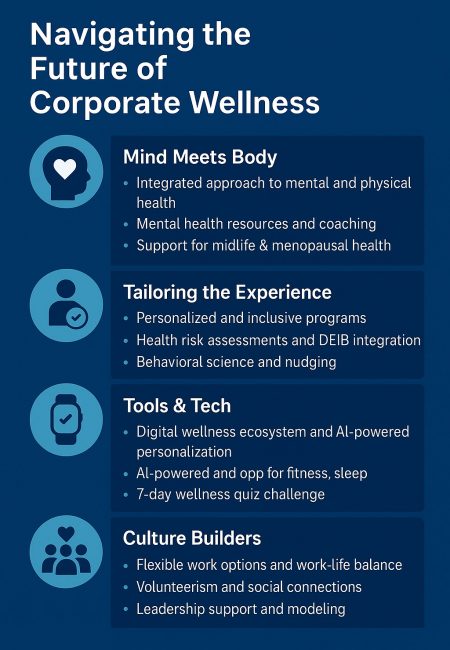Table of Contents
A successful corporate wellness program used to mean free fruit in the kitchen and a flu shot sign-up sheet. Not anymore. The last few years have redefined what employees expect from employers when it comes to wellbeing—and what companies must deliver to remain competitive. Wellness has evolved into a critical element of business strategy, influencing everything from productivity to retention to employer brand perception.
For HR leaders and business owners, the challenge isn’t deciding whether to invest in wellness—it’s understanding where to focus. Which trends matter most? How do you separate meaningful innovation from passing fads? And how do you scale efforts across diverse workforces, job functions, and health profiles?
According to McKinsey’s 2024 report on global wellness trends, 82% of U.S. consumers now place a high value on wellness, making wellness not just a workplace issue, but a cultural shift.

We’ve outlined four key focus areas—each with practical takeaways you can apply today. From mental health to digital tools, these strategies are designed to help you meet evolving employee needs and drive measurable outcomes.
These four pillars reflect where modern wellness is headed—and where your organization can lead. Whether you’re updating a legacy program or starting fresh, the ideas ahead are designed to meet the moment.
If you’re an HR leader or business owner ready to future-proof your wellness strategy, read on.
1. Mind Meets Body: The Rise of Integrated Wellbeing
Case in Point: In one coaching outcomes study, 81% of participants reported increased confidence in achieving their health goals, while 88% credited coaching as a key contributor to success. Measurable improvements included a 70% increase in physical activity, a 20-point average reduction in blood pressure, and an 85% improvement in chronic care management. Wellness program completion rates more than doubled when coaching was paired with digital support—reinforcing that combining personal guidance with scalable technology drives lasting behavior change.
Wellness is no longer just about physical fitness. A holistic approach that integrates mental, emotional, and physical health is now the gold standard.
Key Focus Areas
Strategic capabilities to prioritize when evaluating corporate wellness platforms.
- Mental Health Support: With burnout and stress still high post-pandemic, organizations are prioritizing tools like EAPs, virtual therapy access, and mental health manager training. According to SHRM’s 2024 Workplace Mental Health Report, 42% of HR professionals cited emotional wellbeing as the number one employee need. Health coaching programs that incorporate mental and emotional support can further boost results.
- Sleep Health: Sleep directly impacts mood, productivity, and even chronic disease risk. Employers that provide sleep education and tracking tools often see measurable improvements in absenteeism and performance. A study from the RAND Corporation found that sleep-deprived workers cost U.S. companies $411 billion annually in lost productivity.
- Addressing Loneliness: Social isolation is a hidden epidemic, especially in remote settings. Companies are responding with virtual social events, team challenges, and intentional community-building.
Tip: Layer these efforts together to support the whole person—not just their output.
2. Tailoring the Experience: Inclusivity, Flexibility & Personalization
Case in Point: A coaching outcomes report involving a multi-industry program showed that when participants were offered parallel wellness tracks based on preference and participation data, total engagement increased by more than 60%, and avoidable absenteeism dropped by 14%.

Program Examples
Real-world wellness initiatives aligned with engagement, retention, and ROI goals.
- Flexible Work & Work-Life Balance: Remote options, compressed schedules, and manager training on setting boundaries are now considered foundational to well-being. The American Psychological Association links flexible scheduling to lower stress, higher retention, and better overall health.
- Personalized Programs: Using health risk assessments (HRAs), feedback tools, and preference data to match employees with the right resources. Personalization increases program engagement rates by as much as 70%, according to a 2023 WellSteps employer study. Wellness coaching services, including virtual coaching, can also be customized to individual needs, offering scalable and relevant support.
- Inclusive Design: Ensuring programs are accessible across locations, abilities, and cultures—with DEIB principles woven throughout. Gartner reports that inclusive workplaces are 2.6 times more likely to engage and retain talent.
- Support for Midlife & Menopausal Health: Employers are increasingly recognizing the importance of midlife health—especially for women navigating menopause. Offering educational resources, health coaching, and peer support signals that your organization supports employees at every stage of their journey.
- Behavioral Nudges & Habit Science: More organizations are using behavioral science techniques—like nudging, goal priming, and habit stacking—to help employees follow through on wellness goals. These methods, when integrated into wellness platforms that combine behavior science with user-friendly design, make behavior change easier to start and stick with—especially when paired with small, achievable steps.
Tip: Form employee resource groups to co-create and vet new health and wellness programs.
3. Tools & Tech: Powering Digital Wellness

Case in Point: A commercial employer recently ran a 7-Day Wellness Quiz Challenge where employees completed short interactive quizzes on sleep, stress, and nutrition. 77% of employees participated, and 79% completed the challenge. They reported increased motivation and practical takeaways. The approach reinforced the value of light-touch, digital-first strategies that engage users daily and spark meaningful conversations around health.
Technology is no longer a bonus—it’s the delivery mechanism for modern wellness. In 2025, the best programs will blend convenience with customization, and increasingly use data to anticipate and respond to individual needs.
Platform Capabilities
Features and tools that drive measurable outcomes and long-term value.
- Wellness Portals & Apps: Centralized hubs that offer fitness challenges, health education, and tracking features are now expected. The most effective platforms also integrate with wearable devices and offer nudges to drive daily engagement. Modern wellness platforms are increasingly essential for supporting large and hybrid teams.
- Virtual Coaching & Support: Personalized coaching—delivered remotely—continues to grow in popularity, especially when paired with asynchronous support. Harvard Business Review notes that digital coaching improves behavior change outcomes by 3x over self-guided interventions. The best platforms also use AI-powered personalization to recommend timely, relevant next steps. Virtual coaching tools help scale these efforts while still keeping the experience personal.
- Preventive Care & Screenings: Biometric screenings, health assessments, and on-demand education drive early intervention and reduce long-term healthcare costs. When paired with actionable follow-up support, preventive care can yield an ROI of up to 6:1, according to the American Journal of Health Promotion.
Tip: Choose tech that integrates with existing platforms and offers a seamless user experience. Evidence-based platforms that emphasize flexibility and user experience are increasingly being adopted to help scale workplace wellness efforts effectively—without sacrificing personalization.
4. Culture Builders: Belonging, Meaning & Social Impact
Wellness doesn’t live in a silo. It thrives when it’s woven into the fabric of a healthy company. Employees are more likely to engage with wellness programs when they see them reflected in company values and leadership behavior. Building a culture of well-being means fostering emotional safety, meaningful recognition, social connectedness, and a shared sense of purpose.

Engagement Strategies
Tactics designed to maximize participation and demonstrate program impact.
- 🫱Community Engagement: Volunteering, corporate giving, and cause-based challenges support morale and loyalty. Companies that promote volunteerism report a 13% increase in employee satisfaction (Deloitte, 2023).
- 💰Financial Wellness: Budgeting help, retirement education, and savings tools address one of the top drivers of employee stress. A PwC survey found that 57% of employees cite financial stress as their top distraction at work.
- 🌿Environmental Wellness: Ergonomics, indoor air quality, natural light, and sustainability initiatives can dramatically improve workplace satisfaction.
Tip: Highlight these programs in your recruitment materials. They’re a competitive advantage.
Measuring What Matters: Data-Driven Wellness
Even the most thoughtful wellness initiatives can underperform if they aren’t measured, refined, and optimized. Data doesn’t just help justify budget—it shapes smarter decisions and keeps programs aligned with employee needs and business outcomes. Many HR leaders are moving beyond simple participation rates to more meaningful metrics that capture the full picture of engagement, behavior change, and culture impact.
Best practices:
- Track participation, satisfaction, and health outcomes over time.
- Gather both quantitative and qualitative feedback.
- Measure both ROI (e.g., lower claims) and VOI (e.g., improved morale).
- Use feedback loops to adjust offerings and invest where it matters most.
From Trends to Transformation
For a wellness strategy to truly transform your workplace, it must be both aspirational and actionable. This means tying wellness efforts directly to organizational KPIs such as employee engagement scores, talent retention, and productivity levels. It also means fostering internal alignment: from leadership setting the tone, to middle managers reinforcing participation, to employees feeling empowered to set and pursue goals that matter to them.
The future of corporate wellness lies in the intersection of culture, technology, and behavioral insight. As you evaluate your next steps, start by auditing your current program for gaps in personalization, inclusivity, and leadership support. Consider tools and partners that offer evidence-based approaches and scalable solutions—especially those designed with lasting behavior change in mind.
FAQs: Building a Future-Focused Corporate Wellness Program
Focus on low-cost wins: flexible scheduling, mindfulness resources, and peer-led initiatives. Corporate wellness starts with culture, not just cash.
Combine participation and feedback data with VOI metrics like productivity, morale, and satisfaction scores. Align results with platform insights, such as participation dashboards and learning feedback reports, to identify what's driving sustained engagement.
Listen first. Use surveys and employee resource groups to shape your offerings. Provide varied formats (virtual, in-person, mobile) and design with accessibility in mind. Inclusivity should also extend to life stages—like offering support for midlife and menopausal health.
Balance digital tools with personal touchpoints, like live coaching, group challenges, or peer support. Connection drives change.
Leadership buy-in is essential. When executives and managers actively participate in wellness programs, whether by joining challenges, sharing personal stories, or attending events—it signals that wellbeing is a company value, not just an HR initiative. This modeling behavior significantly increases employee engagement.
Author

Avidon Health is transforming how organizations promote healthier lifestyles through behavior change science and technology-driven coaching. Our mission is to empower individuals to achieve better health outcomes while driving measurable business success for our clients.
With over 20 years of expertise in health coaching and cognitive behavioral training, we’ve built a platform that delivers personalized, 1-to-1 well-being experiences at scale.
Today, organizations use Avidon to reimagine engagement, enhance health, and create lasting behavior change—making wellness more accessible, impactful, and results-driven.
